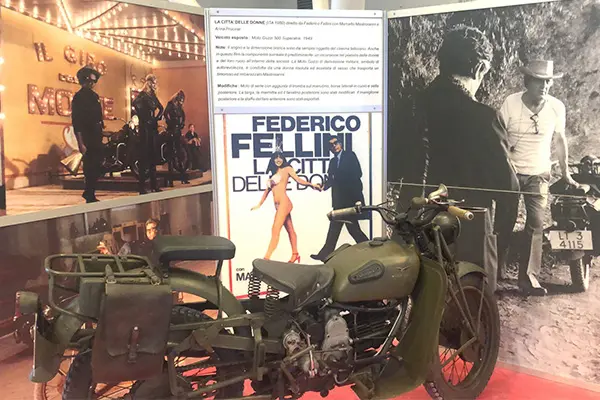The tribute to director Federico Fellini makes Olbia's Costa Smeralda airport unique
Per restare aggiornato entra nel nostro canale Whatsapp
A complete immersion in the evocative cinematographic world of the unique Italian director thanks to an exhibition that tells so much and even more excites the memory. An extraordinary tribute, therefore, to the cinematographic genius of Federico Fellini and to the innovative talent of the editor Leo Catozzo that develops in a journey between wooden clapperboards, posters of the most famous Fellini films and the motorcycles of the master's masterpieces up to the paintings and sketches made by his hand.
The exhibition - La Dolce Vita by Federico Fellini and Leo Catozzo: between dream, magic and reality - will be open throughout December in the spaces of the ArtPort Gallery at the Olbia Costa Smeralda port.
Inaugurated last December 4th, the exhibition was born from the will of the cultural association Il Leone e le Cornucopie with the concession of some iconic examples that have made many of the director's masterpieces famous.
The photographic-documentary exhibition
Anyone who has the opportunity to stop and admire the retrospective curated by journalist Fabio Alescio is lucky enough to get closer to a different aspect of the master. In fact, the protagonists of the first section, located in the Arrivals, are motorcycles, carefully chosen for his films and, sometimes, even designed by himself: elements that have crossed almost all of Fellini's cinematographic production. The two wheels, in fact, although never belonging to the director's personal life, have occupied a symbolic role in his feature films, representing freedom, rebellion and modernity.
“ We started a research group a year ago because we wanted to present a retrospective on Maestro Fellini seen from a perhaps unusual perspective. In an ideal process we therefore came to study even the most unpublished Fellini, the one that emerges from the deep human and professional partnership with Leo Catozzo, ” reports the curator.
The two wheels
Here in the spaces of Olbia airport, each arranged with its own private corner, there are nine icons, all provided by the Sidecar Museum of Cingoli and restored by the film scholar Costantino Frontalini. You can glimpse: Zampanò's three-wheeler from La Strada (1954), a spartan vehicle that recalls the poetic wandering of the character played by Anthony Quinn; the Vespa from the timeless La Dolce Vita , on which the paparazzi fled after having immortalized stolen shots; the Harley-Davidson from the memorable Amarcord , which the director transformed into a fascinating archetype of the motorcyclist; and also the Ducati Indiana 650 from La Voce della Luna (1990), the director's last work, then the sidecar used in I Clowns (1971), which evokes the beloved world of the circus and the Moto Guzzi 500 from La Città delle Donne (1980).
The exhibition is completed with explanatory panels that tell the story of the cinematographic context and the modifications made to the motorcycles to adapt them to the set.
The connection with Leo Catozzo
The second part of the exhibition focuses on the deep human and professional partnership with Leo Catozzo, editor of many of his important films, such as La Strada, Le Notti di Cabiria, La Dolce Vita and 8½. On display are some original prototypes of the famous Catozzo press, an invention that changed film editing forever. The Cabiria was, in fact, used for the first time during the making of Le Notti di Cabiria , giving Leo Catozzo a Technical Achievement Award in 1990.
This second strand of the exhibition offers the public a more intimate aspect of the director. The collaboration with the Catozzo family was fundamental for the presence of various materials from the private archive of his son Alberto.
A multimedia station was then conceived so that the most interested public could entertain themselves with original films and interviews with Federico Fellini.
Beyond the exhibition
The project organized at the ArtPort Gallery of the Olbia Costa Smeralda port is exciting as well as useful to ensure that our memory can still get closer to the great examples that have made Italy immense, in this case cinema. Federico Fellini remains a figure of innovation for his time, poetic and generous in his writings, delicate and enveloping in each of his films that are still a national treasure today.
The President of the cultural association Il Leone e le Cornucopie, Tiziana Biscu, explained the spirit with which everything was built: « An initiative of high cultural value and international vocation, for the first time in Olbia and at the airport, the gateway to the city, which sees many people transit here even during the Christmas period ». During the inauguration, copies of the volume Leo Catozzo: La dolce vita di Fellini e Catozzo , edited by Silvia Nonnato, were distributed.
The exhibition will be accessible to passers-by and the curious until December 31st, with free admission and it will even be possible to attend the screenings of two Oscar-winning films: La Dolce Vita and Amarcord , respectively on December 11th and 13th at 8:00 pm in the version restored by the Cineteca di Bologna. On December 16th starting at 9:00 pm it will be the turn of the double musical event with the performance of the maestro Gian Domenico Anellino who will perform the most famous soundtracks of the cinema and the performance of the Olbia Gospel Group Movin'on Up Gospel Choir who will conclude the evening with Christmas carols.
